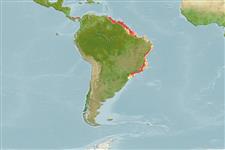Actinopterygii (ray-finned fishes) >
Perciformes (Perch-likes) >
Sciaenidae (Drums or croakers)
Etymology: Isopisthus: Greek, isos = equal + Greek, opisthe = behind (Ref. 45335).
Environment / Climate / Range
Ecology
Marine; brackish; demersal; depth range 1 - 45 m (Ref. 3702). Tropical, preferred ?; 10°N - 27°S, 83°W - 34°W
Western Atlantic: Costa Rica to southern Brazil.
Length at first maturity / Size / Weight / Age
Maturity: Lm 15.9 range ? - ? cm
Max length : 25.0 cm TL male/unsexed; (Ref. 9626); common length : 20.0 cm TL male/unsexed; (Ref. 3702); max. published weight: 240.00 g (Ref. 9626)
Dorsal
spines
(total): 8 - 9;
Dorsal
soft rays
(total): 19-20;
Anal
spines: 2;
Anal
soft rays: 18 - 19. Silver grey, darker above. A diffuse black spot at pectoral-fin bases, fins pale to yellowish. Mouth large, strongly oblique, lower jaw projecting. Upper jaw with a pair of large canine-like teeth at tip. Chin without barbel or pores, lower margin of snout with 2 marginal pores. Two widely separated dorsal fins. Gas bladder with a pair of horn-like anterior appendages. Sagitta (large earstone) moderately thick and oval (Ref 51721).
Found in shallow coastal waters over sandy mud or soft mud bottoms (Ref. 3702). Feeds mainly on small shrimps (Ref. 3702). Important food fish.
Life cycle and mating behavior
Maturity | Reproduction | Spawning | Eggs | Fecundity | Larvae
Cervigón, F., 1993. Los peces marinos de Venezuela. Volume 2. Fundación Científica Los Roques, Caracas,Venezuela. 497 p. (Ref. 9626)
IUCN Red List Status (Ref. 115185)
CITES (Ref. 94142)
Not Evaluated
Threat to humans
Harmless
Human uses
Fisheries: minor commercial; bait: usually
More information
ReferencesAquacultureAquaculture profileStrainsGeneticsAllele frequenciesHeritabilityDiseasesProcessingMass conversion
Tools
Special reports
Download XML
Internet sources
